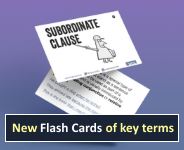Nonsense words and grammar
In this starter activity, students are asked to do two things:
1) Work out the word class of different nonsense words, based on the context in which they appear.
2) Write their own grammatical sentences using their own nonsense words.
Begin by asking students to figure out the word class of each word in the following sentence:
The ravenous students quickly devoured a massive pizza.
The answer is: determiner > adjective > noun > adverb> verb > determiner > adjective > noun
Although determiners aren't necessarily covered at KS1, they are words that introduce nouns, such as the, a, an and this.
Now ask students to work out the word class for each word in this sentence:
The milchy mulchers twongly gribbled a hoddy snib.
The answer is: determiner > adjective > noun > adverb> verb > determiner > adjective > noun
Here then, are two sentences with different words, that follow the same grammatical pattern. But the second sentence uses nonsense words. How did we work out the grammatical category of each word, if they aren't even 'real' words? Let's look at the first nonsense word, which is:
milchy
We said that milchy is an adjective. Here are three reasons which explain how we know:
- It looks like an adjective, having a typical adjective suffix of -y. Other adjectives that take this suffix include dusty, happy, snowy and spooky. How many others can you think of?
- It comes after a determiner (the) but before a word that looks like a noun (mulchers). This is a typical position for adjectives.
- We can swap milchy with another word which we know is definitely an adjective, and see if the sentence still makes grammatical sense. So, we could say the happy milchers gribbled the hoddy snib. This sounds grammatical, and so we can come to the conclusion that milchy is indeed an adjective.
Now, ask your students to do the same for the remaining nonsense words:
mulchers
- It looks like a plural noun, having a typical suffix of -ers. Other plural nouns that take this suffix include teachers, computers, players.
- It comes after an adjective (milchy) and a determiner (the). The milchy mulchers is therefore a noun phrase.
- It can be replaced with another word which we know is definitely a noun, such as teacher.
twongly
- It looks like an adverb, having a typical ending of -ly. Beware that not all adverbs end in this way (e.g. very).
- It appears before a word that looks like a verb: gribbled. This is a typical position for adverbs - although they are very flexible.
- It can be moved around in the sentence. For example, we could say Twongly, the milchy mulchers gribbled the hoddy snib.
gribbled
- It looks like a verb, having a typical suffix of -ed. This form of the verb is the past participle.
- It appears after the Subject of the sentence (The milchy mulchers).
- It can be replaced by another word that we know is a verb. For example, the milchy mulchers twongly destroyed...
hoddy
- This is an adjective for the same reasons as given for milchy, above.
snib
- This looks like a noun, given that it appears after a determiner (a) and an adjective (hoddy). It therefore is the Head word of the noun phrase a hoddy snib.
Now, you could ask your students to write their own nonsense words and put them into sentences. They should apply what they have learnt about word endings and order.
Welcome!

Englicious is totally free for everyone to use!
But in exchange, we ask that you register for an account on our site.
If you’ve already registered, you can log in straight away.
Since this is your first visit today, you can see this page by clicking the button below.
- Printer-friendly version
- Log in to view or leave comments

